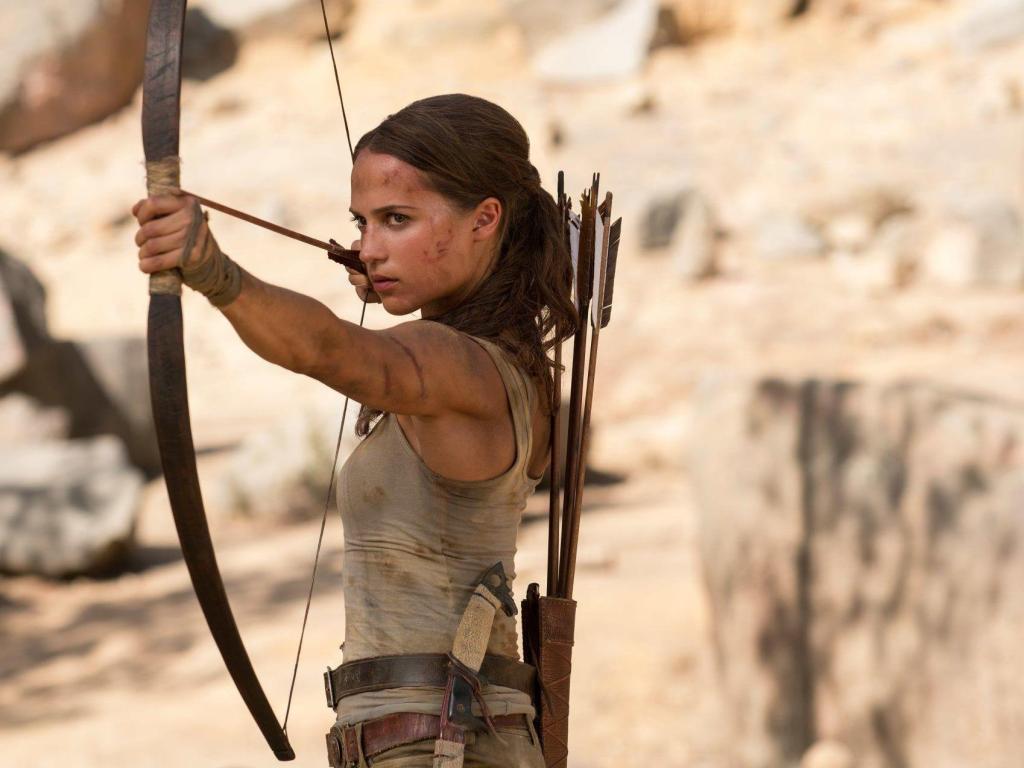When Tomb Raider’s protagonist (Alicia Vikander, Tulip Fever) announces that she’s ‘not that kind of Croft,’ she’s speaking to the keeper of the family fortune and business empire (Kristen Scott Thomas, Darkest Hour). Though there’s no nodding or winking involved – played straight and serious from start to finish, this isn’t a film of nodding and winking – she may as well be speaking to the audience.
Since the multi-platform franchise’s first game in 1996 and subsequent initial screen adaptation in 2001, Lara Croft has largely been objectified more than personified. It’s not just the physical dissimilarities between Vikander’s interpretation of the character, her predecessor Angelina Jolie and the original game’s triangular-breasted figure that herald the arrival of Lara 2.0 in cinemas, however; in the actress’ hands, and under filmmaker Roar Uthaug’s (The Wave) direction, she struggles and suffers, and groans and grimaces and grapples with the consequences of her actions. In short: she’s not a sexualised superhero rampaging from one adventure to the next with few cares in the world and a flimsy spirit of empowerment.
In a feature that’s primarily a formulaic reboot, rendering Lara Craft as flesh and blood instead of a cartoonish fantasy makes a difference. Vikander is both up to the task and an excellent choice for the job, selling the character’s standing in several worlds – the aristocratic upbringing she’s ignoring, and the archeological puzzle-solving and treasure-hunting she doesn’t know she’s born into, as well as the bicycle-courier life she’s slogging through in between – along with her resilient yet vulnerable nature. And while the 2016 The Danish Girl Oscar winner can’t rescue the movie overall, she can certainly brighten it. There’s plenty to be said for watching someone resembling an actual person navigate the narrative’s various scenarios, as opposed to feeling like you’re viewing an attractive avatar in a big-screen video game.
Of course, Uthaug and writers Alastair Siddons (Trespass Against Us) and Geneva Robertson-Dworet still take inspiration from Tomb Raider’s playable beginnings, with the new-and-improved take on the character stemming from the 2013 game reboot of the same name. Here as in there, an origin story unfolds, focused on a version of Lara that’s just learning to fit the titular job description. Accordingly, the film commences with an animated introduction voiced by Lord Richard Croft (Dominic West, TV’s The Affair), explaining the myth of the Japanese Queen Himiko and the cursed space she supposedly now rests in, setting the scene for his own disappearance and his daughter’s eventual quest. Still convinced that her father is alive, Lara is quick to follow in his footsteps once she discovers he’s more than a super-wealthy businessman, hopping from London boxing rings and bike races, to Hong Kong harbourside chases, to sailing towards a mysterious island with drunken sailor Lu Ren (Daniel Wu, Geostorm).
Having already established his action credentials with Norwegian disaster epic The Wave, Uthaug turns each set piece into an engaging, well-staged spectacle. It’s a trend that continues once Lara and Lu Ren arrive at their destination and cross paths with the villainous Mathias Vogel (Walton Goggins, Maze Runner: The Death Cure), who’s also searching for the tomb with the help of shipwrecked prisoners. Alas, like Vikander’s performance, all of the cycling, running, climbing, fighting, cracking codes and other assorted missions make enough of an imprint to lift the feature but not to save it. That’s the script’s doing; with Robertson-Dworet and Siddons sticking so closely to a template on the page, and to clichés and tropes and convenience to go with it, their subpar efforts can’t be patched over by throwing in an impressively handled action scene at regular intervals.
Nor can the sense of repetition that arises as a result. Unleashing the same manoeuvres in increasingly more complicated combinations might be one of the basics of video game-playing, but when that approach is used to prop up a slight story, it eventually starts to become wearying even when done well. That’s just one the film’s debts to its origins that brings mixed fortunes, with the camera placement, often viewing Lara from below or behind, an effective touch, but the jumpy editing proving frazzled more than entertainingly frenetic. And then, predictably, there’s the franchise’s attempt to set up its next cinematic chapter. Wanting to spend more time with Vikander’s Lara and Uthaug’s visuals is understandable, but the heavy-handed angling for a sequel leaves the movie feeling like just another Tomb Raider effort.
2 ½ stars out of 5
Tomb Raider
Director: Roar Uthaug
US, 2018, 118 mins
Release date: March 15
Distributor: Roadshow
Rated: M
Actors:
Director:
Format:
Country:
Release:





